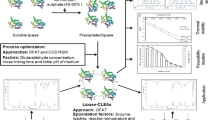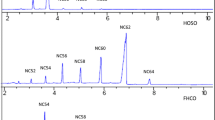Abstract
A new design of cross-linked enzyme aggregates (CLEAs) of Burkholderia cepacia lipase (BCL) based mainly on the use of lignocellulosic residue of palm fiber as an additive was proposed. Different parameters for the preparation of active CLEAs in the hydrolysis of olive oil, such as precipitation agents, crosslinking agent concentration, additives, and coating agents were investigated. The highest activity yield (121.1 ± 0.1%) and volumetric activity (1578.1 ± 2.5 U/mL) were achieved for CLEAs prepared using the combination of a coating step with Triton® X-100 and polyethyleneimine plus the use of palm fiber as an additive. The variations of the secondary structures of BCL-CLEAs were analyzed by second-derivative infrared spectra, mainly indicating a reduction of the α-helix structure, which was responsible for the lipase activation in the supramolecular structure of the CLEAs. Thus, these results provided evidence of an innovative design of BCL-CLEAs as a sustainable and biocompatible opportunity for biotechnology applications.






Similar content being viewed by others
References
Filho DG, Silva AG, Guidini CZ (2019) Lipases: sources, immobilization methods, and industrial applications. Appl Microbiol Biotechnol 103:7399–7423
Mohamad NR, Marzuki NHC, Buang NA, Huyop F, Wahab RA (2015) An overview of technologies for immobilization of enzymes and surface analysis techniques for immobilized enzymes. Biotechnol Biotechnol Equip 29:205–220
Souza RL, Faria EP, Figueiredo R, Fricks A, Zanin G, Santos OA, Lima A, Soares CF (2014) Use of polyethylene glycol in the process of sol–gel encapsulation of Burkholderia cepacia lipase. J Therm Anal Calorim 117:301–306
Adrio LJ, Demain LA (2014) Microbial enzymes: tools for biotechnological processes. Biomolecules. https://doi.org/10.3390/biom4010117
Souza RL, Faria ELP, Figueiredo RT, Mettedi S, Santos OAA, Lima AS, Soares CMF (2017) Protic ionic liquid applied to enhance the immobilization of lipase in sol–gel matrices. J Therm Anal Calorim 128:833–840
Sheldon AR (2019) CLEAs, Combi-CLEAs and ‘Smart’ magnetic CLEAs: biocatalysis in a bio-based economy. Catalysts. https://doi.org/10.3390/catal9030261
Sheldon RA (2007) Cross-linked enzyme aggregates (CLEA®s): stable and recyclable biocatalysts. Biochem Soc Trans 35:1583–1587
Mehde AA, Mehdi WA, Özacar M, Özacar ZZ (2018) Evaluation of different saccharides and chitin as eco-friendly additive to improve the magnetic cross-linked enzyme aggregates (CLEAs) activities. Int J Biol Macromol 118:2040–2050
Cao L, van Rantwijk F, Sheldon RA (2000) Cross-linked enzyme aggregates: a simple and effective method for the immobilization of penicillin acylase. Org Lett 2:1361–1364
Illanes A, Cauerhff A, Wilson L, Castro GR (2012) Recent trends in biocatalysis engineering. Bioresour Technol 115:48–57
Mahmod SS, Yusof F, Jami MS, Khanahmadi S (2016) Optimizing the preparation conditions and characterization of a stable and recyclable cross-linked enzyme aggregate (CLEA)-protease. Bioresour Bioprocess 3:3
Hara P, Hanefeld U, Kanerva LT (2008) Sol–gels and cross-linked aggregates of lipase PS from Burkholderia cepacia and their application in dry organic solvents. J Mol Catal B Enzym 50:80–86
Guimarães JR, Giordano RdLC, Fernandez-Lafuente R, Tardioli PW (2018) Evaluation of strategies to produce highly porous cross-linked aggregates of porcine pancreas lipase with magnetic properties. Molecules. https://doi.org/10.3390/molecules23112993
Mafra CA, Ulrich GL, Kornecki FJ, Fernandez-Lafuente R, Tardioli WP, Ribeiro PM (2019) Combi-CLEAs of glucose oxidase and catalase for conversion of glucose to gluconic acid eliminating the hydrogen peroxide to maintain enzyme activity in a bubble column reactor. Catalysts. https://doi.org/10.3390/catal9080657
Ramos MD, Miranda LP, Giordano RLC, Fernandez-Lafuente R, Kopp W, Tardioli PW (2018) 1,3-Regiospecific ethanolysis of soybean oil catalyzed by crosslinked porcine pancreas lipase aggregates. Biotechnol Prog 34:910–920
Mafra ACO, Kopp W, Beltrame MB, de Giordano RLC, de Ribeiro MPA, Tardioli PW (2016) Diffusion effects of bovine serum albumin on cross-linked aggregates of catalase. J Mol Catal B Enzym 133:107–116
Rojas JM, Amaral-Fonseca M, Zanin MG, Fernandez-Lafuente R, Giordano DR, Tardioli WP (2019) Preparation of crosslinked enzyme aggregates of a thermostable cyclodextrin glucosyltransferase from Thermoanaerobacter sp. critical effect of the crosslinking agent. Catalysts. https://doi.org/10.3390/catal9020120
Amaral-Fonseca M, Kopp W, Giordano DR, Fernández-Lafuente R, Tardioli WP (2018) Preparation of magnetic cross-linked amyloglucosidase aggregates: solving some activity problems. Catalysts. https://doi.org/10.3390/catal8110496
Pan J, Kong X-D, Li C-X, Ye Q, Xu J-H, Imanaka T (2011) Crosslinking of enzyme coaggregate with polyethyleneimine: a simple and promising method for preparing stable biocatalyst of Serratia marcescens lipase. J Mol Catal B Enzym 68:256–261
Datta S, Christena LR, Rajaram YRS (2013) Enzyme immobilization: an overview on techniques and support materials. 3Biotech 3:1–9
Jin W, Xu Y, Yu X-W (2019) Preparation of lipase cross-linked enzyme aggregates in octyl-modified mesocellular foams. Int J Biol Macromol 130:342–347
Park J-M, Kim M, Park H-S, Jang A, Min J, Kim Y-H (2013) Immobilization of lysozyme-CLEA onto electrospun chitosan nanofiber for effective antibacterial applications. Int J Biol Macromol 54:37–43
López-Gallego F, Betancor L, Hidalgo A, Alonso N, Fernández-Lafuente R, Guisán JM (2005) Co-aggregation of enzymes and polyethyleneimine: a simple method to prepare stable and immobilized derivatives of glutaryl acylase. Biomacromology 6:1839–1842
Perna RF, Tiosso PC, Sgobi LM, Vieira AMS, Vieira MF, Tardioli PW, Soares CMF, Zanin GM (2017) Effects of Triton X-100 and PEG on the catalytic properties and thermal stability of lipase from Candida rugosa free and immobilized on glyoxyl-agarose. Open Biochem J 11:66–76
Lowry OH, Rosebrough NJ, Farr AL, Randall RJ (1951) protein measurement with the folin phenol reagent. J Biol Chem 193:265–275
Stoscheck CM (1990) Quantitation of protein. In: Deutscher MP (ed) Methods in enzymology. Academic Press, New York
Soares CMF, De Castro HF, De Moraes FF, Zanin GM (1999) Characterization and utilization of Candida rugosa lipase immobilized on controlled pore silica. Appl Biochem Biotechnol 77–9:745–757
Diaz-Vidal T, Armenta-Perez VP, Rosales-Rivera LC, Mateos-Díaz JC, Rodríguez JA (2019) Cross-linked enzyme aggregates of recombinant Candida antarctica lipase B for the efficient synthesis of olvanil, a nonpungent capsaicin analogue. Biotechnol Prog 35:e2807
López-Serrano P, Cao L, van Rantwijk F, Sheldon RA (2002) Cross-linked enzyme aggregates with enhanced activity: application to lipases. Biotechnol Lett 24:1379–1383
Asakura T, Adachi K, Schwartz E (1978) Stabilizing effect of various organic solvents on protein. J Biol 253:6423–6425
Senan Mahmod S, Yusof F, Jami M (2014) Production of cross-linked enzyme aggregate-lipase from channel catfish (Ictularus punctatus) Viscera. In: International conference on biological, chemical and environmental sciences. https://doi.org/10.15242/IICBE.C614017
Sheldon RA (2011) Characteristic features and biotechnological applications of cross-linked enzyme aggregates (CLEAs). Appl Microbiol Biotechnol 92:467–477
Migneault I, Dartiguenave C, Bertrand MJ, Waldron KC (2004) Glutaraldehyde: behavior in aqueous solution, reaction with proteins, and application to enzyme crosslinking. Biotechniques 37:790–802
Zheng J, Chen Y, Yang L, Li M, Zhang J (2014) Preparation of cross-linked enzyme aggregates of trehalose synthase via co-aggregation with polyethyleneimine. Appl Biochem Biotechnol 174:2067–2078
Virgen-Ortíz JJ, dos Santos JCS, Berenguer-Murcia Á, Barbosa O, Rodrigues RC, Fernandez-Lafuente R (2017) Polyethylenimine: a very useful ionic polymer in the design of immobilized enzyme biocatalysts. J Mater Chem B 5:7461–7490
Mateo C, Abian O, Fernandez-Lafuente R, Guisan JM (2000) Reversible enzyme immobilization via a very strong and nondistorting ionic adsorption on support–polyethylenimine composites. Biotechnol Bioeng 68:98–105
Bolivar JM, Rocha-Martin J, Mateo C, Cava F, Berenguer J, Fernandez-Lafuente R, Guisan JM (2009) Coating of soluble and immobilized enzymes with ionic polymers: full stabilization of the quaternary structure of multimeric enzymes. Biomacromology 10:742–747
Wilson L, Betancor L, Fernández-Lorente G, Fuentes M, Hidalgo A, Guisán JM, Pessela BCC, Fernández-Lafuente R (2004) Cross-linked aggregates of multimeric enzymes: a simple and efficient methodology to stabilize their quaternary structure. Biomacromology 5:814–817
Yan J, Gui X, Wang G, Yan Y (2012) Improving stability and activity of cross-linked enzyme aggregates based on polyethylenimine in hydrolysis of fish oil for enrichment of polyunsaturated fatty acids. Appl Biochem Biotechnol 166:925–932
Barbosa MS, Freire CCC, Souza RL, Cabrera-Padilla RY, Pereira MM, Freire MG, Lima ÁS, Soares CMF (2019) Effects of phosphonium-based ionic liquids on the lipase activity evaluated by experimental results and molecular docking. Biotechnol Prog 35:e2816
Madeira Lau R, Sorgedrager MJ, Carrea G, van Rantwijk F, Secundo F, Sheldon RA (2004) Dissolution of Candida antarctica lipase B in ionic liquids: effects on structure and activity. Green Chem 6:483–487
Wi S, Pancoska P, Keiderling TA (1998) Predictions of protein secondary structures using factor analysis on Fourier transform infrared spectra: Effect of Fourier self-deconvolution of the amide I and amide II bands. Biospectroscopy 4:93–106
Pan S, Liu X, Xie Y, Yi Y, Li C, Yan Y, Liu Y (2010) Esterification activity and conformation studies of Burkholderia cepacia lipase in conventional organic solvents, ionic liquids and their co-solvent mixture media. Biores Technol 101:9822–9824
Acknowledgements
The authors thank the financial support of FAPITEC/SE, Coordenação de Aperfeiçoamento de Pessoal de Nível Superior—Brasil (CAPES)—Finance Code 001; Conselho Nacional de Desenvolvimento Científico e Tecnológico (CNPq); and Universidade Tiradentes (PROSUP II—UNIT) for the scholarship to Alves, N.R. The authors also thank São Paulo Research Foundation (grant 2016/10636-8) for some kind of financial help.
Author information
Authors and Affiliations
Corresponding author
Ethics declarations
Conflict of interest
The authors declare that they have no conflict of interest.
Additional information
Publisher's Note
Springer Nature remains neutral with regard to jurisdictional claims in published maps and institutional affiliations.
Rights and permissions
About this article
Cite this article
Alves, N.R., Pereira, M.M., Giordano, R.L.C. et al. Design for preparation of more active cross-linked enzyme aggregates of Burkholderia cepacia lipase using palm fiber residue. Bioprocess Biosyst Eng 44, 57–66 (2021). https://doi.org/10.1007/s00449-020-02419-0
Received:
Accepted:
Published:
Issue Date:
DOI: https://doi.org/10.1007/s00449-020-02419-0




